Marny Garcia Mommertz visits Anaïs Cheleux in her Guadeloupe studio to chat about sugar-cane syrup and her work at this year's Off Biennale in Dakar.
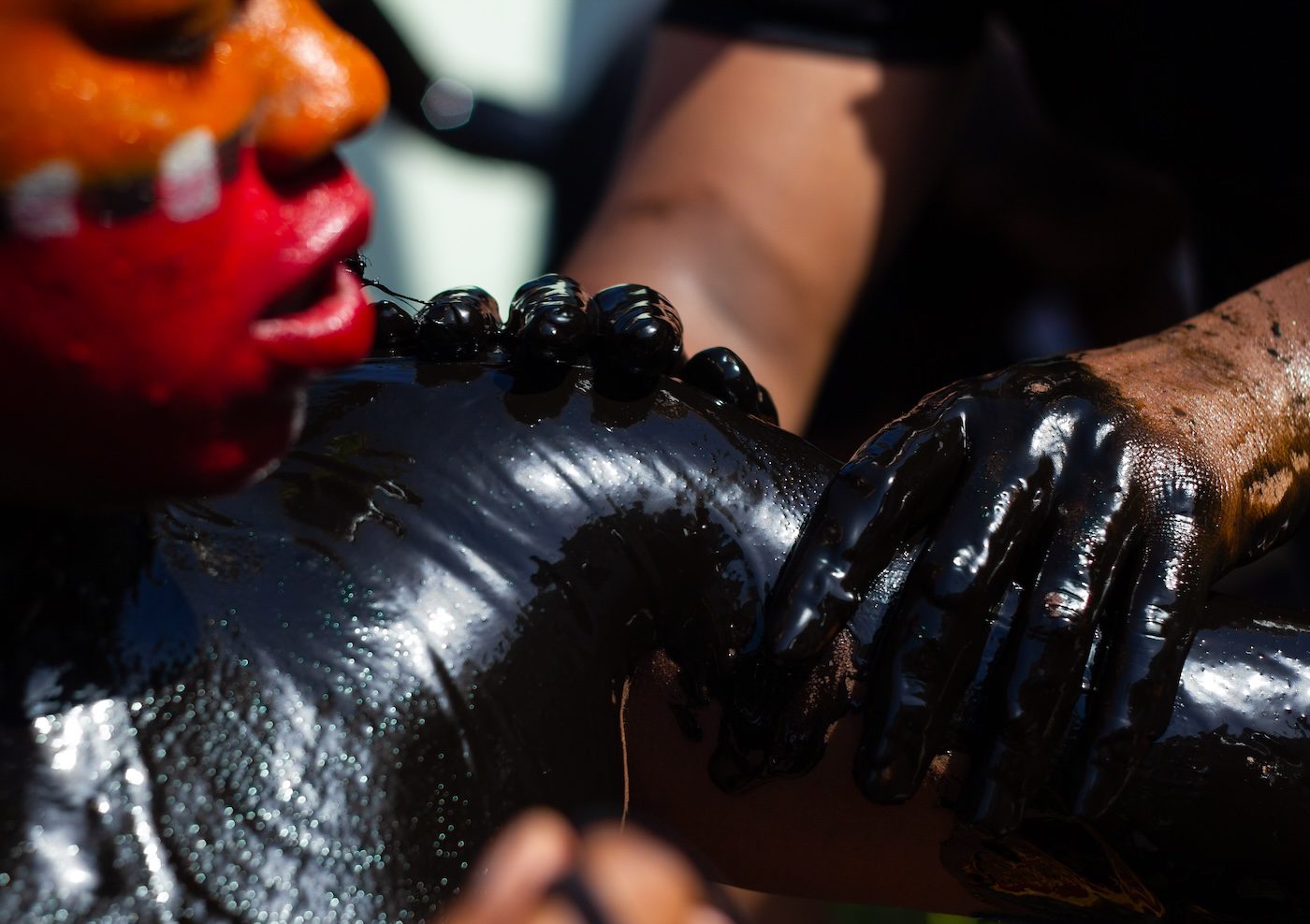
Anaïs Cheleux, Mas Maten, Guadeloupe, shot on digital camera, 2016. Courtesy of the artist.
It is mid-December 2023, and I am at the vernissage of the exhibition (RE)COUTURE by artist Guy Gabon, curated by Minia Biabiany in Point-a-Pitre, Guadeloupe. As I stand in a group of people waiting to be taken on a guided tour, Joëlle Fifi introduces herself. She is a cultural producer who runs Arts au Pluriailes, a local organization that offers support to artists by advising with grant or residency applications, or organizing research and networking trips for young Guadeloupean artists. Suddenly she turns around and points toward a young woman. “This,” she says, “is Anaïs, one of the artists we have been accompanying over the past years.”
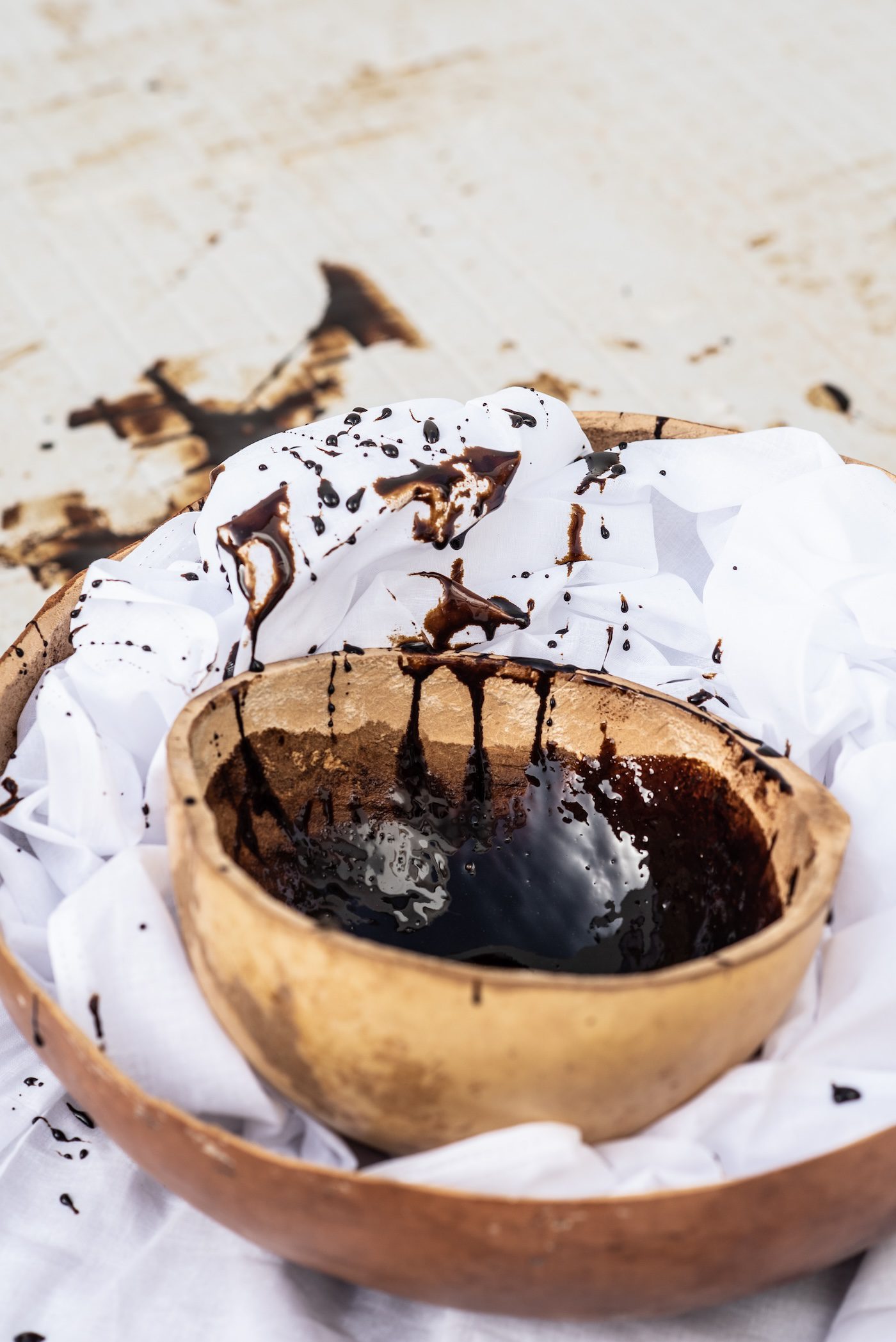
Anaïs Cheleux, performance to mark the abolition of slavery in Martinique, for the opening of the “Ceci n’est pas un pays” exhibition at The OFF Dakar Biennale 2024. Foto: Jean-Baptiste Joire. Courtesy of the artist.
A few evenings later, photographer and performer Anaïs Cheleux waits for me in her car outside the University of the French Antilles in Pointe-à-Pitre. We meet here to drive to her studio in Morne-à-l’Eau, a small town approximately 30 minutes outside the capital. Anaïs, who next to being an artist works as a teacher, finds equilibrium in juggling two professions as teaching provides stability amidst the challenges of pursuing art as a career in a Guadeloupe still shaped by colonial structures.
As we pull up into her parents’ driveway, her mother greets us warmly. Although the artist’s studio is an extension of her parents’ house, it functions as a completely independent living and working space. Bright, spacious, with modern touches and wooden floors that make it feel cozy, the studio has one shelved corner for books and at its center a single wooden stool. Three photographs printed on dibond hang above the grey sofa on which Anaïs and I settle down.
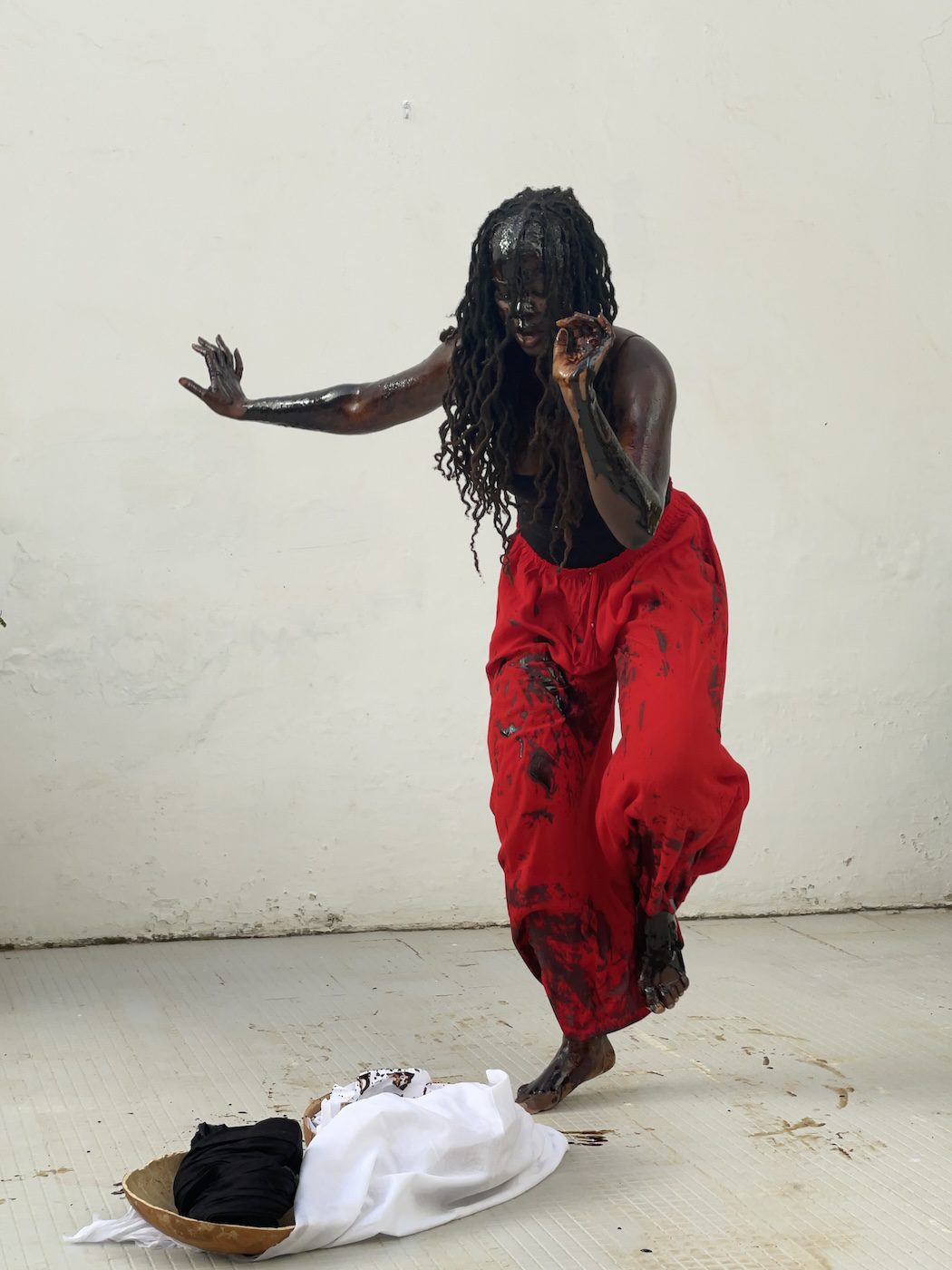
Anaïs Cheleux, performance to mark the abolition of slavery in Martinique, for the opening of the “Ceci n’est pas un pays” exhibition at The OFF Dakar Biennale 2024. Foto: Jean-Baptiste Joire. Courtesy of the artist.
Cheleux has a degree in photography but her practice began long before that, being inherently linked to carnival and her own identity. Besides participating in carnival activities, she began making images of different carnivals in the Caribbean and became fascinated with the use of sugar-cane molasses, gwo siwo in Guadeloupean Creole, as a costume element on people’s skins. “My Guadeloupean identity goes through carnival. That is how I see it and how I live it. Visually, it [carnival] is the gwo siwo for me.” In carnival the syrup, a byproduct of rum production, stands symbolically for maroons,the liberation of enslaved people and the pride in being Afrodescendant.
Its usage in other part of the Caribbean made her question notions of national identity and identify with neighboring cultures. When she saw that it was used in Granada in a similar way to its use in her home country of Guadeloupe she asked herself: “Are we really that different?”

Anaïs Cheleux, Black Blood, Grenada, shot on digital camera, 2018. Courtesy of the artist.
She points out one of the three photographs on the wall from the series Black Blood (2018), which she took in Grenada, and starts playing music from her laptop. I sink deeper into the sofa. “Can you hear the choir, the nostalgia, in the background?” she asks. I listen more intently and underneath layers of quick drum rhythms I hear a choir and faint bells. I look again at the image and I feel for the first time in my life as if I can hear a still image that I did not take myself – even long after the song finishes. Just a few weeks before I had been on a studio visit with Eliazar Ortiz Roa in the Dominican Republic, and through the pigments that they mix themself they had made me smell colors for the first time. Looking at the work of Anaïs, I feel almost entranced, similarly to when I encountered Eliazar’s work.

Anaïs Cheleux, Sé Kon Sa Nou Yé (This is how we are), autoportrait, shot on digital camera, 2018. Courtesy of the artist.
Physical immersion in her work is part of Anaïs’s practice, one that she is continuously, carefully developing. Sé Konsa Nou Yé (Guadeloupean Creole: This is how we are) is a series in which she attempts to let bodies covered in gwo siwo speak. Originally she was working with a dancer friend, but she suggested Anaïs join her in front of the camera. And she did, covering herself in gwo siwo and taking self-portraits. “Something happens when I put gwo siwo onto my skin,” she says. “I feel connected to something else and a certain spirituality.”
This experience being the artist behind and in front of the camera led her to venture into performative art. It makes sense that the space she enters once she performs is a personal one that enables reflection on very intimate questions, too. “It is also about what I express through the body that I do not say with words,” Anaïs tells me. Her performance incorporates questions about how she can express her Guadeloupean identity. “It passes through carnival, it passes through me and the vibration that carnival, the drums, and the gwo siwo bring me.”
In 2022, through an opportunity facilitated by Arts au Pluriailes, she created the performance Les morts ne sont pas morts (French: The Dead Are Not Dead) with the Beninese dance company Cie Noukpo, blending dance and photography, shown at the Festival Couleurs d’Afrique in Ouidah, Benin, and at the Institut Français de Libreville in Gabon in 2023. It was her first performance on the continent and in collaboration with a collective.
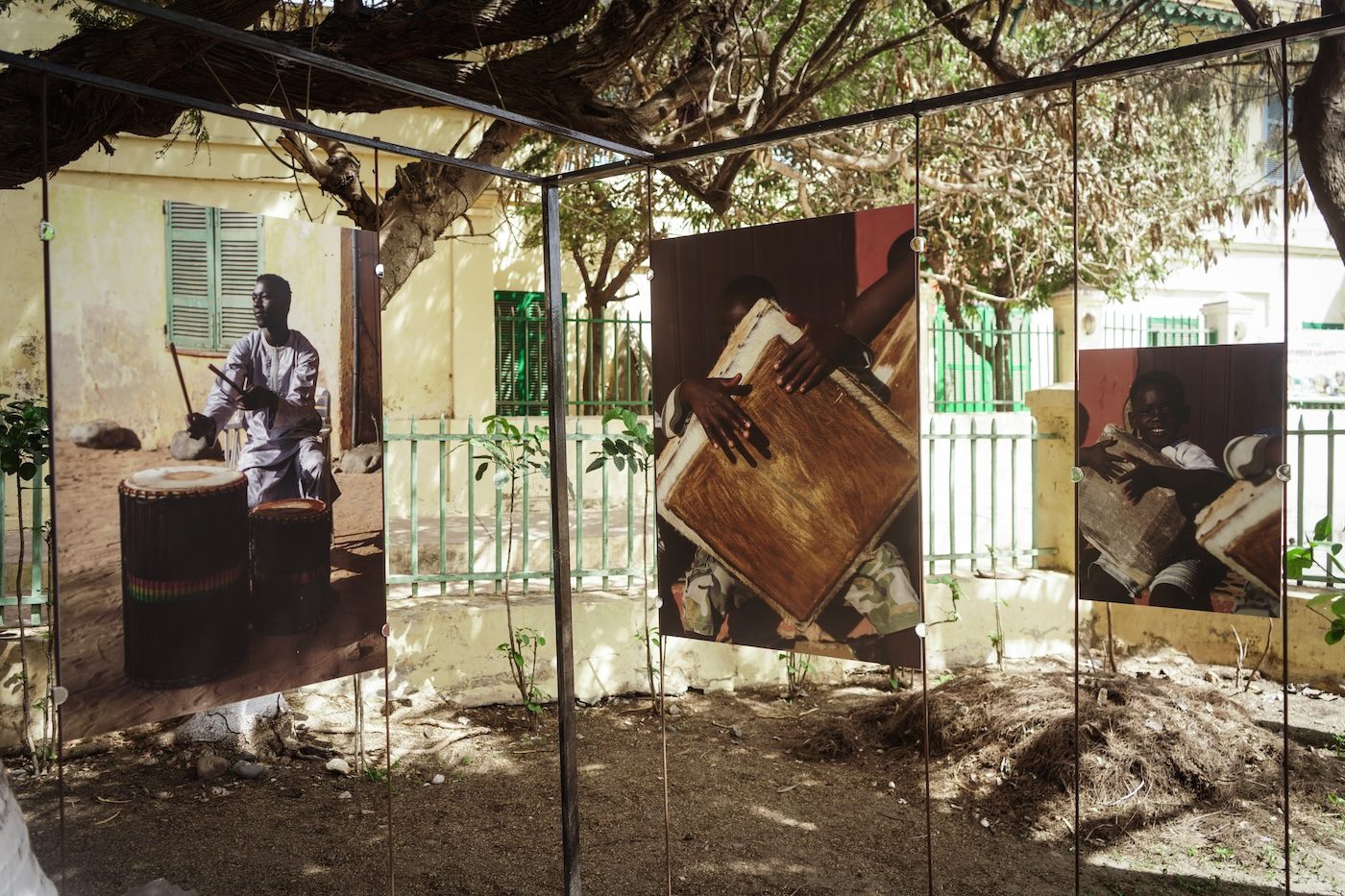
Anaïs Cheleux, Assiko Xama Xol, Île de Gorée, shot on digital camera, 2024. Courtesy of the artist.
Travels, temporary international residencies, and exchange with other artists that work in similar colonial structures are essential to Anaïs Cheleux but, for now, she has no plans to leave her home permanently. On her residencies she engages with the local contexts and ties them back to her identity. On Île de Gorée in 2023, for example, she explored the squared Assiko percussion and its potential for generational transmission, creating a performance that attempts to reconnect old and new generations through a dialogue between Guadeloupean gwoup-a-po and Assiko rhythms. The resulting photo series, Assiko, Xama Xol (Wolof: Assiko, my love), is on display at the 2024 Off Biennale of Dakar alongside a performance (without photographic elements) in the context of the Martinican pavilion titled Ceci n’est pas un pays (French: This is not a country).
Shortly after her trip to Dakar and the postponement of the official Dakar Biennale due to political unrest in May 2024, I send Anaïs a voice note asking about her experience in Dakar. She firmly says that neither The OFF or official Biennale can be overlooked. “For a young artist like me, having The OFF was super important. The stimulation of seeing shows, art practices, works and connecting with galleries is essential, it is business.” Yet, with regret in her voice she also shares that “as a Guadeloupean artist I found it a pity that it was postponed, especially because Guadeloupean artists Stéphanie Melyon-Reinette, Elladj Lincy Deloumeaux and Samuel Gelas are part of the official selection. It seems like with this edition there is a broader opening and recognition of French Caribbean works – and I won’t have the funds to travel to Dakar again in November.”
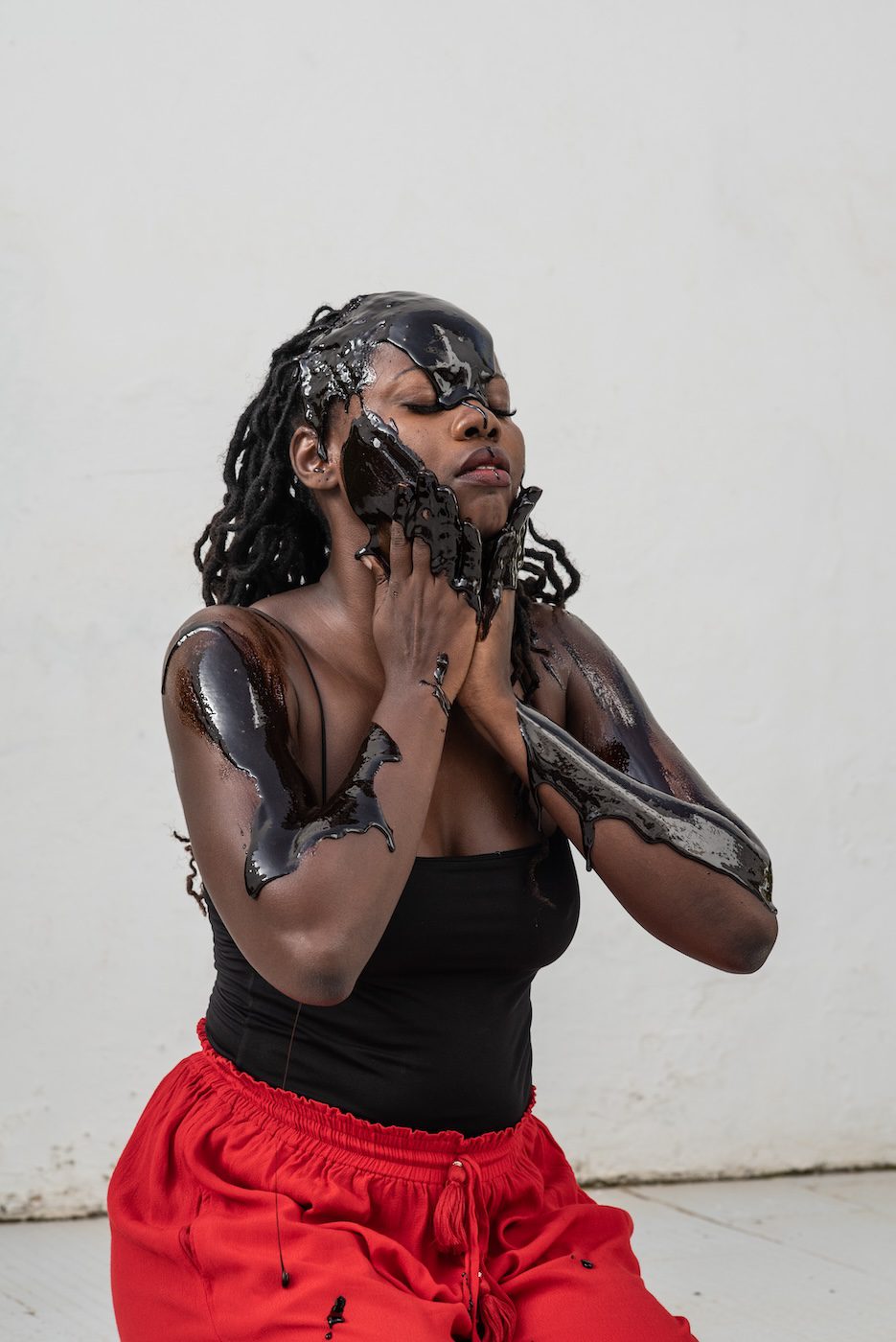
Anaïs Cheleux, performance to mark the abolition of slavery in Martinique, for the opening of the “Ceci n’est pas un pays” exhibition at The OFF Dakar Biennale 2024. Foto: Jean-Baptiste Joire. Courtesy of the artist.
Before Cheleux drives me back, I ask her if I can see some gwo siwo. As she gets up to show me a bottle she says: “I noticed that I still have the same bottle of gwo siwo that I’ve been using since 2020. With time it becomes darker.” Anaïs Cheleux’s exhibition Assiko, Xama Xol was on view from May 18th til June 18th 2024. In June 2024 she takes part in a residency at CIAP of Saint-Laurent du Maroni, in French Guiana, where she plans to exchange with Black communities who have placed dance and body expression at the heart of their identity through both culture and worship.
Anaïs Cheleux is a mixed media artist from Guadeloupe whose work explores Caribbean identity and body dynamics through photography and performance art. In her artistic practice she engages with cultural traditions such as carnival and the use of gwo siwo (molasses). Instagram.
Marny Garcia Mommertz is a writer and artist who explores experimental forms of archiving within the Diaspora and delves into the life of Black woman artist and activist Fasia Jansen, a Holocaust survivor in Germany. Her artistic practice currently focuses on montage. Additionally, she works as the managing editor for C& AL. Instagram.
ON PHOTOGRAPHY
More Editorial